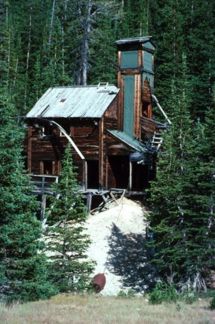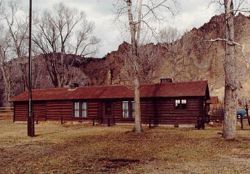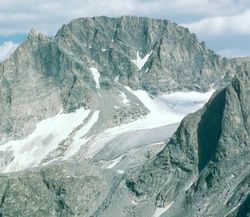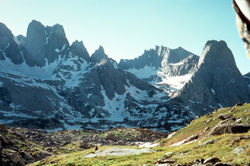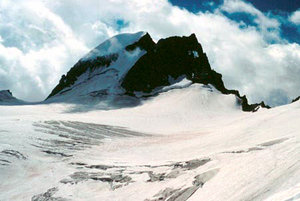Shoshone National Forest
2007 Schools Wikipedia Selection. Related subjects: North American Geography
| Shoshone National Forest | |
|---|---|
| IUCN Category VI (Managed Resource Protected Area) | |
| Location: | Wyoming, USA |
| Nearest city: | Cody, WY |
| Coordinates: | |
| Area: | 2,466,586 acres (9,982 km²) |
| Established: | March 3, 1891 |
| Visitation: | 617,000 (in 2004) |
| Governing body: | U.S. Forest Service |
Shoshone National Forest spans over 2.4 million acres (9,700 km²) in the U.S. state of Wyoming and was the first federally protected forest in the United States. Originally a part of the Yellowstone Timberland Reserve, the forest was created by an act of Congress and signed into law by U.S. President Benjamin Harrison in 1891. A total of four wilderness areas are located within the forest, protecting more than half of the managed land area from development. From sagebrush plains through dense spruce and fir forest to craggy mountain peaks, Shoshone National Forest has a rich biodiversity rarely matched in any protected area.
Three major mountain ranges are partially located in the forest including the Absaroka, the Beartooth and the Wind River Range. Yellowstone National Park forms part of the forest boundary to the west; while south of Yellowstone, the Continental Divide separates the forest from its neighbour, the Bridger-Teton National Forest, to the west. The eastern boundary includes privately owned property, lands managed by the U.S. Bureau of Land Management and the Wind River Indian Reservation, which belongs to the Shoshone and Arapahoe Indians. Custer National Forest along the Montana border is the boundary to the north. The Oregon Trail, the 19th century covered wagon route, passes just south of the forest where broad and gentle South Pass allowed the migrants to bypass the rugged mountains of the forest. All of the forest is a part of the Greater Yellowstone Ecosystem, an unbroken expanse of federally protected lands encompassing an estimated 20 million acres (80,937 km²).
Human history
Shoshone National Forest is named after the Shoshone Indians, who, along with other Native American groups such as the Lakota, Crow and Northern Cheyenne, were the major tribes encountered by the first white explorers into the region. Archeological evidence suggests that the presence of Indian tribes in the area extends back at least 8,000 years. The forest provided an abundance of game meat, wood products, and shelter during the winter months from the more exposed high plains to the east. Portions of the more mountainous regions were frequented by the Shoshone and Sioux (Lakota) for spiritual healing and vision quests. By 1840, Chief Washakie had become the leader of the easternmost branch of the Shoshone Indians. In 1868 he negotiated with the U.S. Government for 2.2 million acres (8,903 km²) to be preserved as tribal lands, known today as the Wind River Indian Reservation. Prior to the establishment of the reservation, the U.S. Cavalry constructed Fort Brown on the reservation lands, which was subsequently renamed Fort Washakie. During the late 1800s, the fort was staffed by African-American members of the U.S Cavalry, better known as the Buffalo Soldiers. Both Chief Washakie and Sacajawea, the Shoshone Indian who provided invaluable assistance to Meriwether Lewis and William Clark during the Lewis and Clark Expedition, are buried at the fort, which is located immediately east of the forest boundary.
In the early 1800s, the forest was visited by mountain men and explorers such as John Colter and Jim Bridger. Colter is the first white man known to have visited both the Yellowstone region and the forest in the period between 1806 and 1808. Having been an original member of the Lewis and Clark Expedition, Colter requested permission from Meriwether Lewis to leave the expedition after it had finished crossing the Rocky Mountains during their return journey from the Pacific Ocean. Colter teamed up with two unaffiliated explorers the expedition had encountered, but soon thereafter decided to explore regions south of where his new partners wished to venture. Traveling first into the northeastern region of what is today Yellowstone National Park, Colter then explored the Absaroka Mountains, crossing over Togwotee Pass and entering the valley known today as Jackson Hole. Colter survived both a grizzly bear attack and a pursuit by a band of Blackfeet Indians that had taken his horse. The explorer later provided William Clark, who had been his commander on the Lewis and Clark Expedition, with previously unknown information on the regions he had explored, which Clark published in 1814.
Travels by fur trappers and adventurers, such as Manuel Lisa and Jim Bridger from 1807 to 1840, completed the exploration of the region. With the decline of the fur trade in the late 1840s and much of the prized beaver long since made scarce by over-trapping, few white explorers entered the forest. Explorations under direction of F.V. Hayden in 1871 were the first federally financed and supported. Hayden was primarily interested in documenting the Yellowstone country west of the forest, but his expedition also established that the forest was a prime resource that merited protection. Travels in the forest in the 1880s by later U.S. President Theodore Roosevelt, who was also a strong advocate of land conservation, provided the impetus that subsequently established the Yellowstone Timberland Reserve in 1891, creating the first national forest in the U.S.
In 1902 President Roosevelt first greatly expanded the reserve and then divided the reserve into four separate units, with the Shoshone being the largest. Upon the creation of the U.S. Forest Service in 1905, the reserve was designated a National Forest, but the current wording and title were formulated forty years later, in 1945. A remnant of the earliest years of the forest management is the Wapiti Ranger Station which is located west of Cody, Wyoming. The station was built in 1903 and is the oldest surviving ranger station in any national forest, and is now listed on the National Register of Historic Places.
During the last decade of the 19th century, minerals such as gold were mined with limited success. The last mine was abandoned in 1907, but panning for gold is still allowed in many areas of the forest, and in most circumstances, no permit is required. After the end of the mining era, numerous camps were established by the Civilian Conservation Corps to help combat unemployment during the Great Depression of the 1930s. The camps housed groups of unemployed men who were paid by the federal government to build roads, hiking trails, and campgrounds for future travelers to the Yellowstone region. Visitation rapidily increased after the end of World War II with the advent of better roads and accessibility to the region.
Forest management
Shoshone National Forest is managed by the U.S. Forest Service, an agency within the U.S. Department of Agriculture. The forest is separated into five districts and has a staff of 145 employees. The annual operating budget is $15,000,000, with much of it from grants. The main headquarters and a visitor centre are located in Cody, Wyoming and a smaller information centre is located in Lander, Wyoming.
As is true with all National Forests in the U.S., Shoshone National Forest practices conservation of resources which ensures a sustainable flow of some raw materials from the forest, such as lumber for construction purposes and wood pulp for paper products. Additionally, mineral extraction through mining and oil and gas exploration and recovery are also conducted, though in Shoshone National Forest this has become less common due to a consensus to protect the pristine nature of region. More common than logging and mining are the lease options that are offered to ranchers to allow them to graze cattle and sheep. The forest provides guidelines and enforces environmental regulations to ensure that resources are not overexploited and that necessary commodities are available for future generations, though conservation groups have voiced concerns over the management practices of the leasing program and especially cattle overgrazing problems.
The efforts of environmentalists combined with public demand led to the creation of wilderness designated zones beginning in 1964 within most U.S. Government land areas that fit the criteria of wilderness. The wilderness designation provides a much higher level of land protection and prohibits any alterations by man to the resource. In Shoshone National Forest, less than ten percent of the total area is utilized for land lease, logging or mineral extraction. The rest of the forest is either designated wilderness, reserved for habitat protection for plants and animals, or set aside for visitor recreation. However, the overgrazing of cattle in riparian areas and into zones not within lease agreements are continuous points of argument. Oil and gas exploration interest groups also lobby to explore regions that may adversely impact wildlife habitat. Plans to build roads into nonwilderness areas for easier extraction of timber have come under fire and are not in compliance with recent legislation that prohibits such construction. Illegal off road motorized transport by all terrain vehicles and snowmobiles continues to be a problem, especially in wilderness areas. Lastly, protection of threatened and endangered species such as the grizzly and wolf is sometimes met with opposition from local ranching interests.
Geography and geology
The altitude in the forest ranges from 4,600 feet (1,402 m) near Cody, Wyoming, to 13,804 feet (4,207 m) at the top of Gannett Peak, an elevation gain of over 9,200 feet (2,800 m). Of the three major mountain ranges found in the forest, they are geologically distinct from each other. All of the mountains are a part of the Rockies and are at the transitional point between the central Rockies and the northern Rockies. The Absaroka Mountains were named after the Crow Indian tribe, although they only inhabited the far northernmost part to the mountain range. The majority of the Absaroka Mountains are contained within the forest, with the highest peak being Francs Peak at 13,153 feet (4009 m). Stretching north to south through the northern and eastern sections of the forest, they span over 100 miles (160 km) from the Montana border to south of Dubois, Wyoming.
Important passes through the Absarokas include Sylvan Pass, which leads to the eastern entrance of Yellowstone National Park; and Togwotee Pass, which provides access to Jackson Hole and Grand Teton National Park. The peaks of the Absaroka are basaltic in origin, having been the result of volcanic activity estimated to have occurred 50 million years ago during the Eocene epoch. The rocks themselves are relatively dark and consist of rhyolite, andesite and breccias. Because of the erosional influences of glaciers and water and the relative softness of the rocks, the Absarokas are quite craggy in appearance. Gold was mined from the slopes of Francs Peak until 1907, and the small ghost town of Kirwin is still visited today. Few lakes exist in the Absarokas, but the headwaters of both the Bighorn and Yellowstone Rivers are found there.
The Beartooth Mountains in the northernmost section of the forest are intrusive igneous and metamorphic in origin, and at 3.96 billion years old, some of these exposed Precambrian rocks are among the oldest found on the Earth. Although oftentimes considered a part of the Absarokas, they are distinct in appearance and geologic history. Uplifted approximately 70 million years ago during the Laramide orogeny, the Beartooths consist of vast windswept plateaus and rugged peaks with sometimes sheer cliff faces. The granite, gneiss and schist rocks are rich in minerals such as chromium and platinum. Iron and magnesium are found in the biotite, amphiboles and pyroxene minerals throughout the range. Quartz and feldspars are also commonly found. Geologists believe that the Beartooth's were at one time at least 20,000 feet (6,096 m) in altitude, but subsequent erosion for tens of millions of years has reduced them to an average of 12,000 feet (3,657 m) for the higher peaks. There are an estimated 300 lakes in the Beartooth region of Shoshone National Forest, some of them left behind by the receding glaciers of the last glacial maximum known as the Pinedale Glaciation, which ended roughly 10,000 years ago. The Beartooth Highway ( U.S. Highway 212) crosses 10,974 foot (3,345 m) Beartooth Pass, and from there descends to the northeast entrance to Yellowstone National Park.
The Wind River Range is in the southern portion of the forest and is composed primarily of granitic rock, gneiss and schist. Gannett Peak is the highest peak in Wyoming, and another seven peaks also exceed 13,500 feet (4,115 m). At one time, Fremont Peak was thought to be the tallest mountain in the Rocky Mountains due to its prominence when viewed from the Oregon Trail. In total, over 230 mountains rise above 12,000 feet (3,600 m). This range is also popular with mountain climbers from all over the world because of its solid rock and variety of routes. The Cirque of the Towers in the Popo Agie Wilderness is one of the more popular climbing and hiking destinations, and an estimated 200 different climbing routes are located within the peaks that surround the cirque. Hundreds of lakes are located in this region as are the headwaters of the Wind River.
Altogether, over 500 lakes are located in the forest, as well as 2,500 miles (4,023 km) of streams and rivers. The Clarks Fork of the Yellowstone River is designated as a National Wild and Scenic River for 22 miles (35 km) through the forest, with cliffs towering up to 2,000 feet (610 m) as the river winds through a gorge. All of the forest is located on the eastern slopes of the Continental Divide, and all the rivers that flow out of the forest eventually empty into the Atlantic Ocean basin.
Glaciology
According to the U.S. Forest Service, Shoshone National Forest has the most individual glaciers in any single U.S. National Forest in the Rocky Mountains. According to the forest recreation guide, there are sixteen named and 140 unnamed glaciers within the forest, all of which are located in the Wind River Range. Forty-four of these glaciers are found in the Fitzpatrick Wilderness, centered around the highest mountain peaks. However, the state water board for Wyoming lists only 63 glaciers for the entire Wind River Range, and this includes areas outside the forest boundaries. While there is little doubt that the forest has more glaciers than any other in the rockies, there is no controversy that all of the glaciers in the forest are retreating rapidly.
Reversing the growth that occurred during the Little Ice Age (1350–1850), there has been a reduction of mountain glacial ice worldwide of 50% since 1850. Much of this reduction has been well documented by photographic evidence and other data. An increase in recession rate since the 1970s, however, seems to be correlated with anthropogenic global warming.
The behaviour of the glaciers of Shoshone National Forest is consistent with this pattern. The area covered by glaciers shrank by 50 percent in the century after they were first photographed in the late 1890s. Research between 1950 and 1999 demonstrated that the glaciers shrank by over a third of their size over that period. Research also indicates that the glacial retreat was proportionately greater in the 1990s than in any other decade of the last 100 years. Gannett Glacier, on the northeast slope of Gannett Peak, is the largest single glacier in the U.S. Rocky Mountains. It has reportedly lost over 50 percent of its volume since 1920 with 25 percent of that loss since 1980.
The small glaciers found in the forest are less able to resist melting as compared to the great ice sheets of Greenland and Antarctica, that are also clearly showing evidence of shrinkage. Once a glacier begins retreating it may fall into disequilibrium and be unable to find mass balance (accumulation versus abalation rate} at any size. Without a favorable climate change, it will continue to retreat until it disappears. Glaciologists believe that if the current trends continue, by the middle of the 21st century, all the remaining glaciers in the forest will have disappeared. Shrinkage already reduces the summer glacial runoff that supplies water to streams and lakes and provides a cold-water source vital to certain fish and plant species. This, in turn, may have a significant impact on the forest ecosystem over time.
Climate
With an average of less than 10 inches (25 cm) of precipitation annually, Wyoming is generally considered an arid state. However, Shoshone National Forest is located in some of the largest mountain ranges in the state, which ensure that glaciers and snowmelt provide water for streams through the dry summer months. The average temperature at the lower elevations is 72 °F (22.2 °C) during the summer and 20 °F (−6.7 °C) during the winter, and the higher peaks average 20 °F (−6.7 °C) below those figures. The hottest temperature ever recorded is 105 °F (40.6 °C), while a reading of −52 °F (−47 °C) was recorded in 1993. Most of the precipitation falls in the winter and early spring, while summer is punctuated with widely scattered afternoon and evening thunderstorms. The fall is usually cool and dry. Due to the altitude and dryness of the atmosphere, vigorous radiative cooling occurs throughout the year, and temperature variances of 50 °F (10 °C) daily are normal. Consequently, the nights range from very cool in the summer to extremely cold in the winter; therefore, visitors should always remember to bring along at least a jacket, even during the summer.
Recreation
Over half a million visitors will spend at least one night in the forest in an average year, and the majority of tourists visit between June and September. Two visitor centers provide orientation, books, maps, and interpretive displays and are staffed by either forest service interpreters or volunteers. The Wapiti Wayside is located on the Buffalo Bill Cody Scenic Byway, west of Cody, Wyoming adjacent to the historic Wapiti Ranger Station. Another visitor centre is located to the south in Lander, Wyoming. There are 30 vehicle access campgrounds in the forest with up to 27 individual sites each. Approximately half of these campgrounds provide running water and restroom facilities and also provide for handicapped accessibility. Referred to as "front country" campgrounds, they also permit recreational vehicle access in most cases. All of the campgrounds are on a first come, first served basis except for the Rex Hale campground, which is on the National Recreation Reservation Service; a phone and web-based system that permits campsite reservation months ahead of time. Due to the presence of Grizzly Bears, some of the campgrounds require what is referred to as "hard-sided" camping only, and tent camping is not permitted.
For some visitors the greater solitude of the "backcountry" requires accessing hiking trails and then backpacking or horseback riding into more remote destinations. There are dozens of trails which total over 1,500 miles (2,400 km) spread throughout the forest. The Continental Divide Trail weaves its way through the forest, though it follows alternatively named trails for some of the distance. There is also the Nez Perce National Historic Trail and the Beartooth Loop National Recreation Trail, both of which are in the northern regions of the forest. Some remote areas can be accessed by horseback. Trailheads usually provide enough room for horse and pack animal trailers plus personal vehicles. Along forest access roads, all terrain vehicles are allowed, however there are plans to limit their use in most of the forest.
Hunting and fishing are popular recreational activities permitted throughout the forest, provided that proper permits are obtained and the applicable rules and regulations are followed. Hunting regulations are altered each year to ensure certain species are protected from overhunting and to maximize personal safety. Many of the streams and rivers are considered to be "Blue Ribbon Trout Streams". 1,700 miles (2,735 km) of streams and 500 lakes that can be legally fished from, provide plenty of elbow room during even the most crowded of fishing seasons. Hunting and fishing licenses are sponsored by the state of Wyoming and are available through the state department of fish and game.
The southern section of the forest in the Wind River Range is the primary destination for mountain climbers. Twenty-nine of the highest 30 peaks in Wyoming are located here, and the mountains are primarily of granitic rock with countless cliffs and sheer rock walls. The Cirque of the Towers is particularly popular as it has numerous peaks within a relatively short distance of each other.
Winter activities include cross-country skiing and snowmobiling. The Continental Divide Snowmobile Trail is a popular maintained snowmobile route that can be accessed from Togwotee Pass. With up to 40 feet (12.2 m) of snow annually in the higher elevations, the snowmobile season extends usually from the beginning of December to the middle of April. Lander, Cody and the area near Togwotee Pass are the hubs of snowmobile activity in the forest. Numerous outfitters rent snowmobiles on a daily basis and can provide guided trips for those less experienced, and a number of motels also remain open during the winter to provide food and lodging. Snowmobile activity has increased in the forest with increased restrictions on their use within Yellowstone National Park.
Scenic roads
As a gateway to two entrances leading into Yellowstone National Park from the east, the forest has a number of scenic roadways. A federally designated All-American Road, the Beartooth Highway ( U.S. Highway 212), weaves through the forest and serves as the northeastern entranceway to Yellowstone National Park. Immediately south of the Beartooth Highway, the Chief Joseph Scenic Byway (Wyoming route 296) follows the old trail in which Chief Joseph and the Nez Perce tribe attempted to flee the U.S. Cavalry in 1877. South of there, Buffalo Bill Cody Scenic Byway (US 14/16/20) heads west from Cody, Wyoming and crosses Sylvan Pass as it enters Yellowstone. Lastly, the Wyoming Centennial Scenic Byway (US 26/287) heads west from Dubois, Wyoming, over Togwotee Pass and enters Jackson Hole and Grand Teton National Park. The Chief Joseph, Buffalo Bill Cody and Wyoming Centennial byways have all been designated by the U.S. Government as National Scenic Byways.
Additional reading
- William J. Fritz (1985). Roadside Geology of the Yellowstone Country. Mountain Press Publishing Company, Missoula. ISBN 0-87842-170-X.
- John O. Whitaker, National Audubon Society Staff (1996). National Audubon Society Field Guide to North American Mammals. Knopf Publishing Group, New York, N.Y.. ISBN 0-679-44631-1.
- Elbert L. Little (1980). National Audubon Society Field Guide to North American Trees: Western Edition. Knopf Publishing Group, New York, N.Y.. ISBN 0-394-50761-4.
- Robert Marshall M. Utley (2004). After Lewis and Clark: Mountain Men and the Paths to the Pacific. Bison Books, Univ. of Nebraska Press, Lincoln, NE. ISBN 0-8032-9564-2.
- Rebecca Woods (1994). Walking the Winds: A Hiking and Fishing Guide to Wyoming's Wind River Range. White Willow Publishing, Jackson WY. ISBN 0-9642423-0-3.




